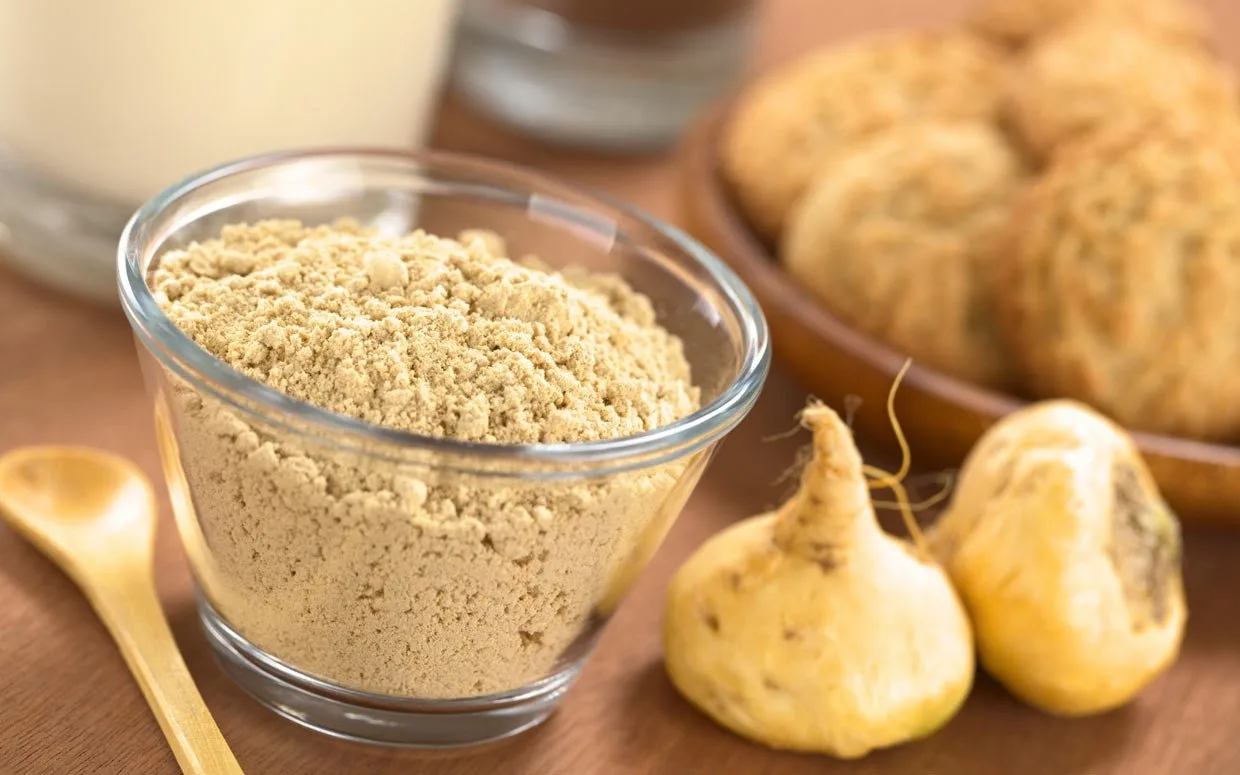Maca root is a magical addition to a healthy diet that we see all over Instagram. It’s like people are obsessed with shoving down all of Earth’s plant powders. First, it was green matcha and now it’s maca. It’s a little confusing right? However, there is a method to the madness and good reason why we should eat more plant-based meals and supplements. Maca root is a plant famous for its legendary ability to deliver energy, mental clarity and enhance sex drive for centuries.
If you’re trying to find a natural remedy to help with a variety of health issues then this is the herb for you! Despite there not being a ton of hard evidence to prove its effectiveness. Rest assured – the root won’t let you down. Maca root originates from a Peruvian plant called Maca. The local people of Peru revere its health benefits. And because of its amazing reputation, the rest of the world is now celebrating its benefits.
Some of these include fighting fatigue, enhancing mood, and the root’s aphrodisiac qualities. Plus, maca is fantastic for women, in particular. This is because of its powerful ability to cure hormonal problems and treat menopausal signs and symptoms.
Maca Root Is the New Sex Superfood
Interestingly, the root is also known as Peruvian ginseng. This has caused waves across social media within the health, fitness, and wellness industries. I think maca is particularly popular with ladies and, even gents, in fitness. I say this because when you’re really fit a lot can cause your hormones to go out of whack.![maca root [longevity live]](https://longevitylive.com/wp-content/uploads/2018/11/affair-anniversary-asad-1024975-320x214.jpg)
You can test this out right now! Click on your Instagram and search ‘maca powder,’ and you will definitely see thousands of people tossing plant powder into their coffees, smoothies, oats, and baked goods. The question is, do these maca root innovations really do any good for your health?
The answer is yes. There’s a reason why Peruvian locals have praised it for thousands of years. In addition, there is some research that can back its benefits up.
What Is Maca Root?
First, you need to understand what this random root is. It is a relative of the cruciferous vegetable family just like kale, cauliflower, and radishes. The National Institutes of Health states that it has been grown in the Andes mountains of Peru for the last 3,000 years because it’s used as traditional medicine. The root is also a key ingredient in a fermented drink called maca chicha.
Research states that just one-half teaspoon (2.5 grams) of maca root powder contains about 10 percent of your daily iron needs, 10 percent of your recommended vitamin C, and about 15 percent of your copper needs. The bonus is that the powder is also very low in energy, only reaching 10 calories.
But it’s not only beneficial to your general health and waistline. It’s pretty much a form of medicine. Peruvian people and homeopathic doctors use it frequently to help treat anemia and chronic fatigue syndrome. Apparently, the root can also boost your energy, stamina, and athletic performance. There you go fitness fundis! Reports have even said that people take maca to help prevent stomach cancer, leukemia, HIV/AIDS, osteoporosis, and tuberculosis. Whether it can really prevent these diseases is a different topic for a different day. However, I believe there might be some power in taking it. What do you have to lose? Nothing really.
![maca root [longevity live]](https://longevitylive.com/wp-content/uploads/2018/11/download-6.jpg)
What’s the bottom line? Well, the NIH says there’s not yet enough hard evidence to rate the effectiveness of maca to treat any of these conditions.
Maca Root Is a Powerful Aphrodisiac
I think we’ve established that the plant has a wide range of health benefits. But, according to most research, its main benefit seems to be its phenomenal ability to amplify your sex drive. Now, female or male, there are many reasons you could be lacking in the sexual desire department. You will need to take into consideration factors like stress, fatigue, burnout, overtraining, hormone imbalances, sexual dysfunction, and even relationship issues.
I know from a fitness perspective and as a woman, we can mess up our hormones quite a bit if we over-train and use up too much energy. Luckily, the maca root has been reported to significantly assist many women – and males in this regard.

Salena Zanotti, M.D., an ob-gyn at Cleveland Clinic, says that a low sex drive can affect between 36 and 50 percent of women. She adds that it’s a challenging one to measure because many women are not honest about the problem. However, there is some promising research available that says the maca root may help.
Christy Brissette, R.D., president of 80 Twenty Nutrition, states that there are a few small studies that demonstrate a libido boost in both men and women after taking one and a half to three grams of maca a day for one to six months. That’s pretty good! But don’t rely entirely on the results because Christy does state that even this study is not enough to scientifically prove that it works.
Should You Use It Anyways?
All in all, there isn’t concrete evidence behind its effectiveness. But, we think you should try it if you would like to improve these problems in your body.
There is some research that found that maca root might even improve sperm count and motility in men. Better yet, there is also earlier research suggesting that taking maca can slightly improve sexual dysfunction in women taking antidepressants. Like I said before, these studies are very small and not 100% reliable.
You’ve got nothing to lose by trying it yourself. The root is certainly not bad for you. There may not be a lot of medical evidence to support natural remedies, but there are enough anecdotal reports to justify trying it. We would recommend establishing the root cause of your libido decrease first with a doctor and then seeking natural remedies to help assist your recovery.
How Can You Eat More Of It?
You can get creative. Don’t be afraid to add a teaspoon of it to your daily meals.
Maca powder works well in smoothies, cappuccinos, guacamole, or hummus. This is because of its tasty nutty flavor and butterscotch aroma. You can also combine it into your homemade baked goods or protein pancakes. You can even add it to soups and stews.
Health experts recommend using between one and a half to three grams of maca per day. This is about a quarter to a half of a teaspoon. This seems to be the amount that works according to those small studies we discussed earlier in the article.



![women [longevity live]](https://longevitylive.com/wp-content/uploads/2020/01/photo-of-women-walking-down-the-street-1116984-100x100.jpg)










